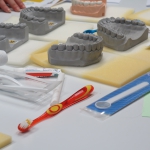Evolutionary analysis Predicts Sensitive Positions of MMP20 and Validates Newly- and previously-Identified MMP20 Mutations Causing Amelogenis Imperfecta
2017 / English – Frontiers in Physiology 2017; 8: 398
Gasse B, Prasad M, Delgado S, Huckert M, Kawczynski M, Garret-Bernardin A, Lopez-Cazaux S, Bailleul-Forestier I, Manière MC, Stoetzel C, Bloch-Zupan A, Sire JY.
“Amelogenesis imperfecta (AI) designates a group of genetic diseases characterized by a large range of enamel disorders causing important social and health problems. These defects can result from mutations in enamel matrix proteins or protease encoding genes. A range of mutations in the enamel cleavage enzyme matrix metalloproteinase-20 gene (MMP20) produce enamel defects of varying severity. To address how various alterations produce a range of AI phenotypes, we performed a targeted analysis to find MMP20 mutations in French patients diagnosed with non-syndromic AI. Genomic DNA was isolated from saliva and MMP20 exons and exon-intron boundaries sequenced. We identified several homozygous or heterozygous mutations, putatively involved in the AI phenotypes. To validate missense mutations and predict sensitive positions in the MMP20 sequence, we evolutionarily compared 75 sequences extracted from the public databases using the Datamonkey webserver. These sequences were representative of mammalian lineages, covering more than 150 million years of evolution. This analysis allowed us to find 324 sensitive positions (out of the 483 MMP20 residues), pinpoint functionally important domains, and build an evolutionary chart of important conserved MMP20 regions. This is an efficient tool to identify new- and previously-identified mutations. We thus identified six functional MMP20 mutations in unrelated families, finding two novel mutated sites. The genotypes and phenotypes of these six mutations are described and compared. To date, 13 MMP20 mutations causing AI have been reported, making these genotypes and associated hypomature enamel phenotypes the most frequent in AI.”
Read the article: https://www.ncbi.nlm.nih.gov/pmc/articles/PMC5469888/


















